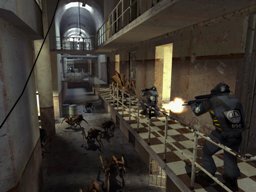Physical Form in Digital Space
BELIEVABILITY FACTOR
The tainted first-person and selling the virtual body
 After taking a few computer games out for a quick spin at a local cyber cafe, I’ve got to say that I was not nearly as impressed as I thought I would be about the graphical representations of players on the screen.
After taking a few computer games out for a quick spin at a local cyber cafe, I’ve got to say that I was not nearly as impressed as I thought I would be about the graphical representations of players on the screen.
Being a gaming newbie, I admit I did not progress very far in any of the selections that I booted up, including Battlefield Vietnam, Diablo II Lord of Destruction, Warcraft III Frozen Throne, and Half-Life. I did, however, spend enough time in each program to roughly gauge the potential each had for engaging the player. What I was mainly focused on was the physical representation of the body in the virtual environment, which is an important element in creating an immersive and rewardingly interactive experience.
In a nutshell, I was more happy in most cases with the navigability of the characters than I was with the perspective provided to the user from behind the computer keyboard — a perspective that does play a role in how fully players can identify with their animated screen personae. For example, in Battlefield Vietnam, the player is depicted from a first-person standpoint via a U.S. soldier inserted into combat in the jungles of Vietnam. The sound effects were quite good, but the visual illusion was inherently flawed.
That’s because rather than participating in the program without a representation of the character’s body, a portion of the soldier whose persona you have adopted remains within view at all times, chiefly in the form of two very masculine hands that are grasping your weapon of choice while trading fire with the enemy or merely scanning the simulated landscape. The player, for instance, is able to see the soldier’s left forearm balancing an M16 assault rifle, with the hand clenching and unclenching its fingers from time to time to relieve stiffness. The right hand, meanwhile, also remains visible on-screen in order to portray the trigger finger.

Battlefield Vietnam spoils the true first-person
perspective by displaying the soldier’s arms and
hands.
In my opinion, I’d rather have the two very manly extremities go away so that I could imagine for myself what I look like. That would help with the fantasy because it would make it easier for me to feel like I was “there.” Then again, since the hands are so integral to the game, perhaps players should be offered a selection of them, just as they are when they get to choose which solider they want to portray or which weapons they want to take onto the battlefield with them. Maybe I want two women’s hands with nicely manicured fingernails painted in red polish, for instance.
Conversely, Diablo II Lord of Destruction offers a third-person experience. But even this vantage point leaves a lot to be desired in this particular game since the characters are smallish and are visible from too much of a distance, making the player feel too removed from the action. That said, third-person play can indeed be done better, as I have experienced firsthand in PlayStation’s Kill All Humans.
To its credit, one of the strong points of Lord of Destruction was the ease with which players are able to control their characters’ movement. After all, it can’t get much simpler then pressing down on left click and guiding the on-screen pointed-finger icon in the direction where you wish your character to run or walk.

Players navigate the characters’ movements in
Diablo II Lord of Destruction by using left click to
control the direction of the hand icon, depicted
at the center of this photo.
Speaking of navigability, Half-Life earned big points in this department. In fact, the game was the most engrossing one I have tried thus far, due to its impressive use of emergent artificial/tactical intelligence, expansive graphics, and the relative finesse with which you can steer your character, namely by using the keyboard’s arrow keys. Sometimes the movement can seem so realistic that you can get downright dizzy while zipping down the digital corridors of the Black Mesa Research Labs, for example. Best of all, the game offers a true first-person experience, in that no part of the user’s body is depicted on the screen, helping make the experience more believable.
– Noche Kandora
_______________________________________________________
Photo ID top: Screenshot from Half-Life computer game.
Photo sources: Half-Life, Battlefield Vietnam, Diablo II Lord of Destruction.
_______________________________________________________
No Comments
No comments yet.
Leave a comment
You must be logged in to post a comment.











